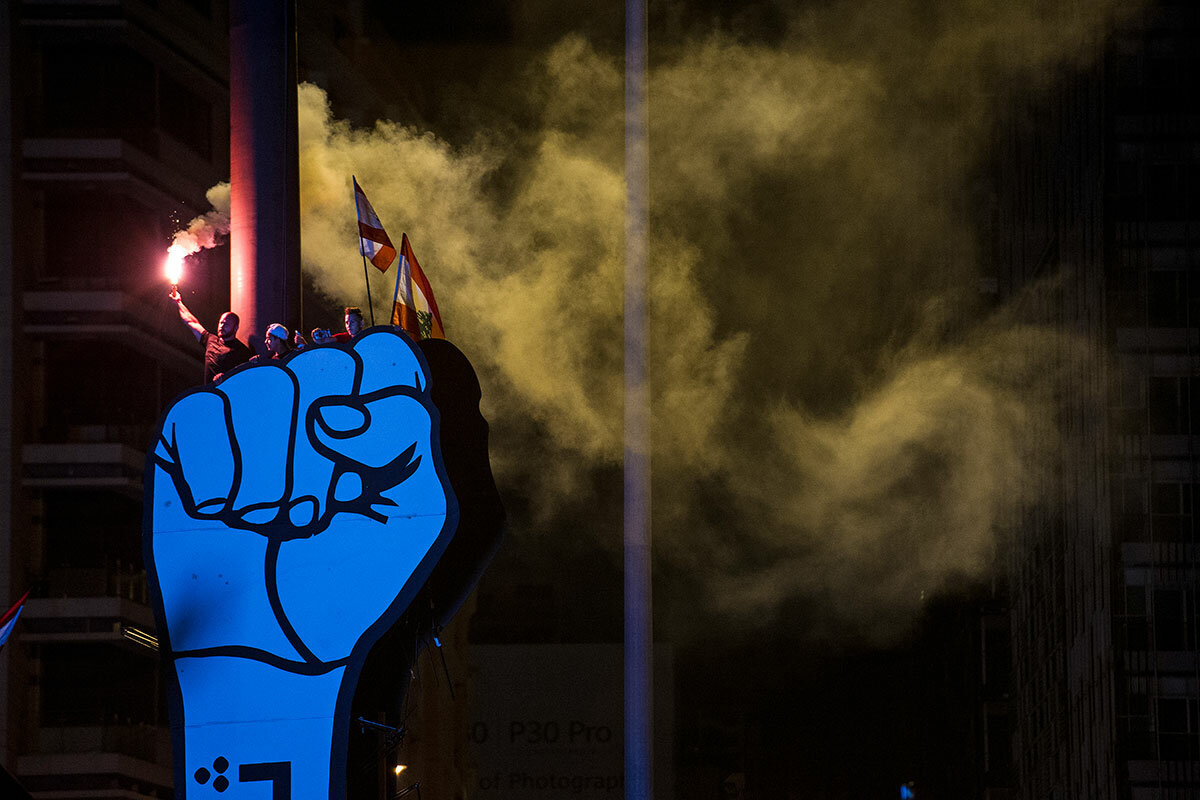How Lebanese youth stand alone, speaking their truth to power
Loading...
| BEIRUT
Nisrine Hammoud wears the Lebanese flag draped around her shoulders like a badge of optimism for the future. She is not alone, surrounded by thousands of energized protesters in Beirut’s central square, chanting, singing, and demanding top-to-bottom political change.
But Ms. Hammoud, and the hundreds of thousands of Lebanese who launched a spontaneous street “revolution” across the country on Oct. 17, are very alone standing up to the Goliath of entrenched sectarian interests that have defined politics here for decades, but now fallen into disrepute, corruption, and the failure to provide even basic services.
Protesters “are just supporting each other,” says the 20-something college graduate, but have no outside backing besides local businesses providing food and water – and night club DJs providing pounding electronic dance music at rallies.
Why We Wrote This
Lebanon’s sectarian elites tried blaming foreign powers for the anti-corruption protests sweeping the country, but in truth the young protesters have only each other to rely on for support.
The protesters have set the precedent for change by identifying as “citizens” of Lebanon first, and only second as Muslim Shiites, Sunnis, or Christians from among Lebanon’s 18 myriad sects – if they note their sect at all.
Triggered by an announced tax on free internet calls, the protests have exposed a visceral anger with the ruling elite and a depth of discontent that last week led to the resignation of the prime minister, Saad Hariri.
“We feel like we are alive again, because we’re used to people just stealing our money, we’re used to all of this corruption,” says Ms. Hammoud, who traveled from the northern city of Tripoli, after a mass overnight rally there, to attend a “unity” rally in Beirut on Sunday.
“But now we’re glad people finally woke up and realized we should not be following these so-called leaders,” she says.
The question is whether the force of people power alone in Lebanon – which some consider part of an Arab Spring 2.0 that includes momentous street uprisings this year in Iraq, Algeria, and Sudan – can prompt lasting revolutionary change in the social contract between Lebanon’s citizens and their rulers.
“The street is very determined. People are absolutely adamant. They understand that now we’ve embarked on this road there is no turning back,” says Maha Yahya, director of the Carnegie Middle East Center in Beirut.
“There is something fundamental shifting beneath society, and we can see it,” she says. “It is palpable; we can touch it. But where it’s going to lead, we still don’t know.”
Ms. Yahya says she has been struck by the energy and spirit of the protests, but notes that changing the political system so dramatically is akin to committing “collective political suicide” for Lebanon’s traditional power centers, which could prompt a violent backlash.
“They understand what’s at stake, but they are quite fearless,” she says of the protesters she has spoken to at rallies. “There’s a generation out there that’s just going for it. They have nothing left to lose. ... They really want to have a country that they are proud to be in, that can actually be a home to them.”
Critical juncture
The protests have now reached a critical moment, as their novelty has worn off. Efforts by the Shiite Hezbollah and Amal movements to attack some rallies resulted in headlines but had little lasting impact. And a counter-rally mounted by Maronite Christian supporters of President Michel Aoun on Sunday showed how thousands of his followers still cling to their sect, even though they suffer from the same grievances as all other Lebanese.
There are few signs that Mr. Aoun is on the verge of naming a promised cabinet of technocrats. And protest tactics to block streets and close banks and schools can anger ordinary people as much as they pressure rulers.
“It’s very emotional to be here every single day. We are so fed up,” says Zeinab, a 30-something banker at the Beirut rally who asked that only her first name be used.
Her eyes tear up during chants led from the stage of “No more sects,” and vows not to be dispersed if the rally is attacked.
“I’m afraid. We still have some people who follow their sects,” says Zeinab. “We all came here from all over, but I don’t know what result we will have. ... It is not a revolution until we achieve what we are here for.”
Lebanon’s sectarian leaders “understand” the demands, she says, but they are “still in denial.” Yet the stakes are high, at such a historic moment.
“We have to get justice, we have to stay optimistic, because if we lose this optimism, things will crash and people will just go home,” says Ms. Hammoud.
“So we’re trying our best to stay here [on the streets],” she says. “The only chance we have is the election we are asking for. It’s up to us. It’s up to the people to decide if they are going to go back to their old ways, or we’re going to go forward.”
Power versus power
Yet the fight is likely to be a long one, analysts say, to change Lebanon’s sectarian system of governance – prevalent for decades, and exacerbated by Lebanon’s 1975-1990 civil war – in which top posts are divided between sects ruled by men portrayed as heroes and often the sole saviors of their community. They become accordingly wealthy and often pass leadership from father to son in family dynasties.
For those Lebanese who have taken to the streets, that zero-sum system has outlived its purpose and only serves to enrich the political elite, while keeping ordinary Lebanese poor and scrambling for services.
“It’s hard to know how things are going to move, because the force of the demonstrators is really powerful, and the tenacity of the old guard is equally powerful,” says Rami Khouri, a professor at the American University of Beirut (AUB), contacted in Doha, Qatar.
Protesters are “facing them down on their own,” he says, while sectarian leaders “don’t understand that the citizenry will no longer put up with the old sharing-the-pie game.”
“The old system worked OK until about 10 years ago, and then it started to get so outrageously corrupt and inefficient, and uncaring, that the majority of people started suffering,” says Professor Khouri, who is also a senior fellow at the Harvard Kennedy School.
“So a majority of Lebanese now are poor, vulnerable, marginalized, and suffering from electricity cuts, lousy education, no jobs for their kids,” he says. “When it was 10% of the population that was suffering, [the old guard] could get away with it. But now probably 60% or 70% of the population is really feeling the pain.”
Yet the result is far from clear, says Mr. Khouri: “These are tough, old, and violent men. They will not easily move aside. They will keep trying to find ways to keep their finger in the pie.”
A long-term game
That is what worries protesters, as they take to the street day after day, in city after city, demanding a total overhaul of their nation’s method of governance. Cosmetic changes won’t do, when politicians have left the economy on the verge of collapse, and citizens hungry.
“This is going to be a long-term game. But already this movement has been significant, both in its geographical reach and its slogans,” says Carmen Geha, an activist and an assistant professor at AUB who studies protest movements.
“There has really been reconciliation between north and south Lebanon, between groups that have been pitted against each other for many, many years,” says Professor Geha. “So it has already succeeded in uprooting a certain political culture, and the gains that will come I think will be huge, but it will take time.”
The idea of reconciliation as united “citizens,” and resistance to elites trying to preserve their influence, echoes at Lebanon’s rallies, where Ms. Hammoud says protesters have “got out of their comfort zone” to erase the sectarian mindset.
“It’s been a very long time,” she says, looking at the vast crowd waving Lebanese flags. “People are highly affected by their parents, by the areas they are living in. So you can’t just in 15 days get these [sectarian] thoughts out of their minds. ... But we’re trying our best to keep people awake, to spread awareness, so people can get rid of this thing.”








